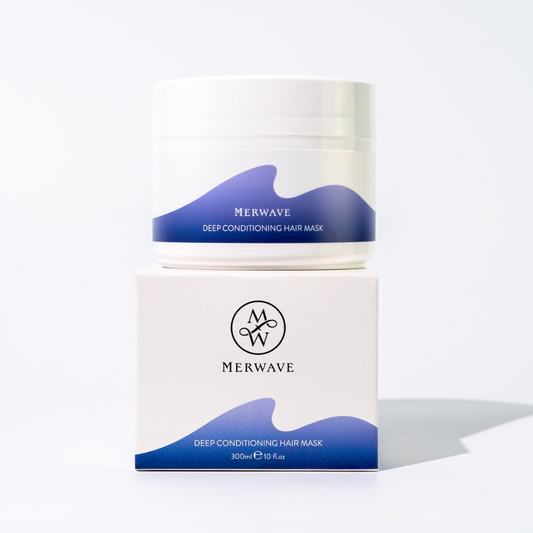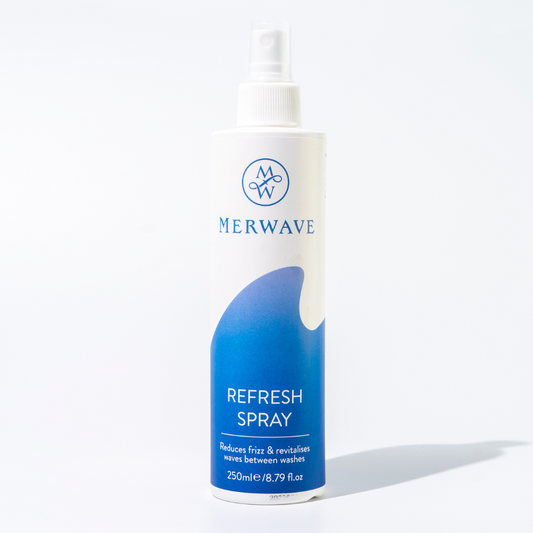Surviving The Wavy Hair Transition Period
How to guide
The wavy hair transition period is the phase where you stop using heat tools or chemical treatments and opt to embrace your natural waves.
During this time, your hair will transition from its processed state to its natural wavy form.
As your hair recovers and adapts to reveal its true texture, it can bring about various difficulties.
3 signs your hair is transitioning...

1. My hair is more oily than usual
Using sulphate shampoos strips your hair of its natural oils, causing your scalp to overproduce oil.
Switching to a sulphate-free shampoo (like Merwave Cleanse) takes time for your scalp to adjust and produce less oil.
2. My hair has a weird wave pattern
As your natural waves begin to emerge, you may notice an uneven texture.
Some sections of your hair might remain straighter while others become wavy or curly.
This inconsistency can be frustrating and make styling challenging.
3. I'm struggling with frizz
Wavy hair is prone to frizz. You've likely got use to frizz free locks from years of straightening or using curling tools.
As your hair adjusts to its natural state, it may struggle to retain moisture, leading to frizzier strands.
Tips to overcome these challenges...

1. Add moisture to prevent frizz
A deep conditioning mask will provide your hair with a huge hydration boost.
2. Use a plex treatment
Years of using heat tools will damage your hair. It'll become dry, rough and brittle.
A plex treatment re-builds your hair bonds, strengthening the hair from within.
It'll become healthier and shiner.
3. Play around with product quantities
Some people require lots of foam and gel to create those defined waves. For others too much product will make their hair appear greasy and limp.
Start with less product and add more if required.
4. Get a wavy hair cut
Adding layers will add volume and movement.
It'll accentuate your natural texture, enhancing the shape of your natural waves.
It'll also remove damaged ends, which cause frizz.
Find a wavy salon near you here.
Transitioning to wavy hair is a journey that requires patience and acceptance.
If you've been used to a polished appearance, then messier, imperfect waves will take time to get use to.
Trust the process. It'll be worth it!
-
-
 Sold out
Sold out -
Deep Conditioning Hair Mask
Regular price £23Regular priceUnit price / per -
Refresh Spray
Regular price £16Regular priceUnit price / per
More Articles
View all-

How to prevent your waves from falling flat
Ellen HollidayWaves are delicate. If they’re not treated right, they lose their shape.Below are our top tips for longer-lasting waves...
How to prevent your waves from falling flat
by Abi ReidWaves are delicate. If they’re not treated right, they lose their shape.Below are our top tips for longer-lasting waves...
-

Can you straighten your hair between washes?
Ellen HollidayStraightening your hair once won’t ruin your waves. Although your hair is incredibly tough, exposing it to temperatures above 180°C when straightening can damage its protective cuticles.These cuticles form a hard...
Can you straighten your hair between washes?
by Abi ReidStraightening your hair once won’t ruin your waves. Although your hair is incredibly tough, exposing it to temperatures above 180°C when straightening can damage its protective cuticles.These cuticles form a hard...
-

How often should you wash your hair?
Ellen HollidayI wash my hair once every 10 days. Sounds gross. But there’s a method behind the madness. Let me explain why you should try and wash your hair less frequently...
How often should you wash your hair?
by Abi ReidI wash my hair once every 10 days. Sounds gross. But there’s a method behind the madness. Let me explain why you should try and wash your hair less frequently...







